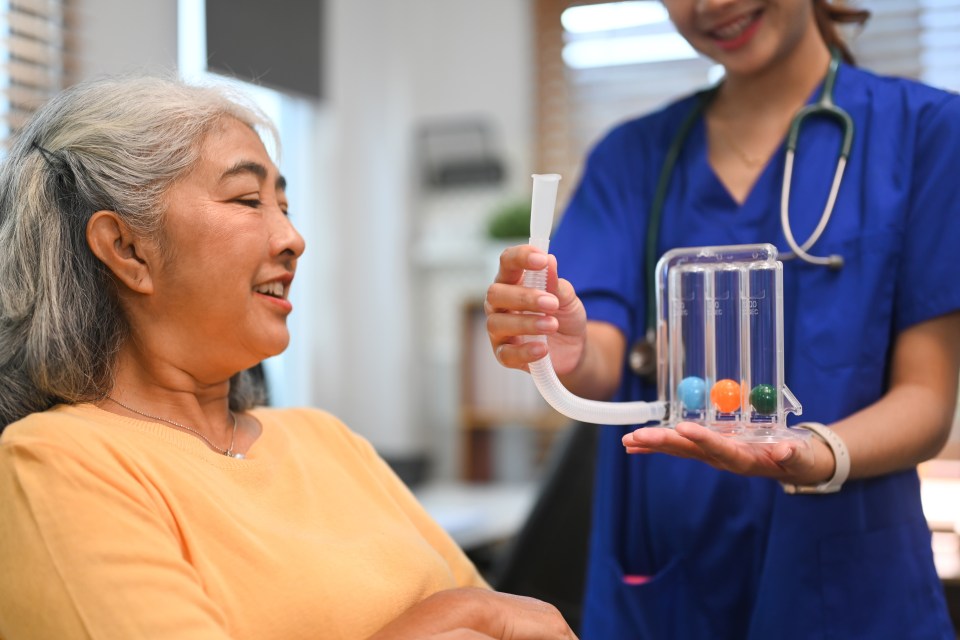As you get older, activities that used to be simple can leave you feeling breathless. If you frequently feel out of breath to the point that it is interfering with your daily life, though, it may be time to get tested for COPD.
COPD stands for chronic obstructive pulmonary disease and is used to describe a variety of progressive lung diseases, including emphysema and chronic bronchitis. If you have COPD, swelling and extra mucus in the airways of your lungs make it difficult to breathe. While there is no cure, there are COPD treatment options that can improve your quality of life.
“If you can’t breathe, you can’t do anything, so it’s very important to get treatment,” said Aman Dhaliwal, a respiratory therapist at Encompass Health Rehabilitation Hospital of Bakersfield in California. “COPD is not something that you can cure, but it is something you can control with proper treatment, medicine and education.”
COPD Symptoms and Causes
Smoking is the No. 1 cause of COPD, but there are other factors that can put you at risk for developing COPD. In addition to smoking and second-hand smoke, other causes could include pollutants found in the workplace or home such as ammonia and asbestos, as well as certain types of molds.
There are a variety of COPD symptoms, but the most common is breathlessness.
“That’s always No. 1,” Dhaliwal said. “When you’re looking at COPD, basically, it’s shortness of breath.”
Other COPD symptoms could include:
- Increased breathlessness when you are not physically active
- Persistent or worsening cough
- Increased mucus and congestion in the chest and lungs
- Wheezing

COPD Stages and Treatment
COPD is a progressive disease, meaning it worsens over time. A COPD exacerbation, or sudden worsening of your symptoms, could be a sign that the disease is progressing, but with proper treatments, the disease can be managed and lived with for many years.
COPD stages are usually classified from one to four, with four being the most severe. When you are diagnosed with COPD, your doctor can tell you what stage of the disease you are in by using a spirometry test, which measures your lung strength.
COPD symptoms and possible COPD treatments by stage are:
Stage 1
This is when the disease is just starting, said Dhaliwal. You may notice a little difficulty breathing, but probably not enough to need aggressive treatments. It is not uncommon for the disease to go unnoticed or mistaken for regular aging. The disease is considered mild at this stage.
Stage 2
At this stage of COPD, breathing is becoming a little more difficult and noticeable. You may require an inhaler to help improve your breathing. Education is also critical at this point. Seeing a pulmonologist, a doctor who specializes in the respiratory system, is beneficial at this time. COPD treatments could include bronchodilator drugs, which make breathing easier, as well as oxygen therapy.
Stage 3
In stage three of COPD stages, the airways are more restricted, and at this point, difficulty breathing could be affecting your daily life. At this point you may require more bronchodilators and oxygen to manage your COPD symptoms. A pulmonary rehabilitation program might be beneficial at this time, as well. Dhaliwal said respiratory therapists can help you with your breathing techniques and educate you on how to best manage the disease.
Stage 4
This is the most severe stage of COPD. Also known as end stage COPD, at this stage, doing any activities can be very difficult, as breathing is more challenging and exacerbations are more frequent. You and your care team may want to consider if surgery is an option or if you might be eligible for a lung transplant.
Breathing Exercises for COPD
Much of living with COPD is about learning how to manage your symptoms, Dhaliwal said. As a respiratory therapist, she educates her patients on anything from using an oxygen tank to breathing techniques.
The following are some of her tips for those trying to manage their COPD symptoms and breath easier:
- Diaphragm breathing, also known as abdominal or belly breathing, can be an effective breathing technique. With this type of breathing you take deep breaths in and out consciously using your diaphragm. This allows you to use your lungs to their full capacity. Normal breathing does not. Dhaliwal said the easiest way to perform diaphragm breathing is by laying down and placing one hand on your stomach and the other on your chest. “If you see the hand on your chest rising, you’re not using your diaphragm,” she said. Instead, the hand on your stomach should be rising as you inhale.
- Pursed lip breathing is another technique Dhaliwal often instructs her patients to use. It’s a medical term, she said, but it’s best described as smelling the roses and blowing out the candles. “Basically, you take more time to exhale then inhale,” she said. “You take a short breath and smell the roses; then a long exhale blowing out the candles.” Dhaliwal advises doing this a couple of times in a row.
- If these techniques are not helpful and breathing is becoming more challenging, call your pulmonologist, and resist the temptation to increase your oxygen. “Too much oxygen can be very dangerous; you can overdose,” Dhaliwal said. “Try these breathing techniques, and if you’re still short of breath call your doctor and see if it’s OK to increase your oxygen.”
The content of this site is for informational purposes only and should not be taken as professional medical advice. Always seek the advice of your physician or other qualified healthcare provider with any questions you may have regarding any medical conditions or treatments.



